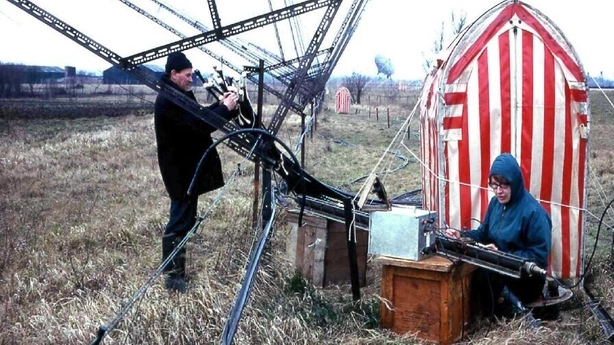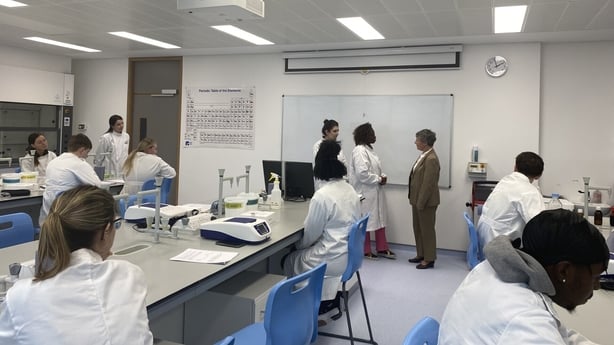A Northern Ireland born astrophysicist has been honoured with a new building unveiled in her name at Dundalk Institute of Technology (DkIT).
Professor Jocelyn Bell Burnell attended the official opening of the new science building at DkIT this afternoon.
She said it was a delight to visit the new building and that she was very impressed with the work that was going on there.
Originally from Lurgan in Co Armagh, Prof Bell Burnell is best known for her 1967 discovery of pulsars.
Pulsars are rapidly rotating neutron stars that emit radio waves, almost like the beams from a lighthouse.
Explaining her discovery of pulsars, Prof Bell Burnell used an analogy for light.
"You know the way a light house works, it swings a beam around the sky. I was finding stars swinging radio beams around the sky,"
She said neutron stars were extremely compact, compared to regular stars.
"Stars are enormous things but these are only about ten miles across, so they're small even by terrestrial standards."
While she said she was not sure if her discovery had changed the world we live in, she said that in terms of science, "it made black holes seem much more possible, because black holes are the next step beyond this".
"I won’t say we’re comfortable with black holes, but we know of a lot of black holes, we’re learning how they behave and so on," she said.
She was 24 years old and a PHD student at Cambridge University at the time. This discovery was later awarded the Nobel prize for physics, although Prof Bell Burnell herself did not receive the award.
Today, said she had no regrets about what happened, but that she thinks it was a mistake.
"I think if I were working for the Nobel prize committee, I would probably say that was a mistake.
"And the Nobel Prize Committee has gotten better at recognising young researchers, as well as the senior people who lead the work.
"It's often the young ones who do an awful lot of the work, so it’s good if they’re getting recognised and I can see that change now."
A former president of the Institute of Physics, Prof Bell Burnell has received countless internationally recognised awards and honours over the course of her career.
She became the second woman to receive the world's oldest scientific award, the Copley Medal in 2021, counting Albert Einstein, Benjamin Franklin, Dorothy Hodgkin, and Charles Darwin among her fellow medal recipients.
In 2018, the scientist also received the Special Breakthrough Prize for Fundamental Physics for her discovery and a "lifetime of inspiring scientific leadership".

As well as her groundbreaking work, Prof Bell Burnell is also known as an advocate for female and marginalised students.
The $3 million prize that came with her 2018 win, now funds a scholarship programme in her name.
Students at DkIT started using the new facilities at the Jocelyn Bell Burnell Science Building at the start of this term in September.
The new facility includes laboratory provisions for studies including analytical and pharmaceutical science, food technology, molecular biology and biotechnology.
Dr Edel Healy, Head of the School of Health and Science said that DKIT plans to increase capacity in its life science, health science and agri-food programmes to help meet the growing demand from employers in the region.
The building was opened by Minister for Further and Higher Education, Research, Innovation and Science Simon Harris this afternoon.
Funding of over €18 million was approved by the Department for the project, which was funded through the Higher Education Authority and delivered through Project Ireland 2040.
Minister Harris said the building was a "really important development for higher education in the North Eastern Region" and that its construction will "improve the educational experience for current and future generations of students".
Speaking before a plaque was unveiled, he said the building was an €18 million investment in science facilities and he said he hoped the building being named after Prof Bell Burnell would inspire women and girls in particular to take up careers in science.
He said that apart from being a scientist from the region, Prof Bell Burnell represents inclusivity and improved education pathways for all.
The opening took place during Science Week, which earlier saw the Government give approval for Ireland to join CERN.
"This is one of the largest scientific research bodies in Europe and now Ireland is finally going to join.
"All going well, we should actually be a member by the end of 2024, not to take anything for granted with the application process," Mr Harris said.

Dr Diamuid O’Callaghan, President of DkIT described it as an historic day.
"Our new science building, provides state of the art facilities for both undergraduate, postgraduate and PhD students.
"It will allow us to develop a number of new courses to meet regional and national needs in the sector and will lead to increased intake of students in both existing and new programmes."
Dr O’Callaghan said that Prof Jocelyn Bell Burnell has been "a visionary in her field of expertise, astrophysics, and has relentlessly championed under-represented groups".
"We hope to emulate her example in the Jocelyn Bell Burnell Science Building," he added.






